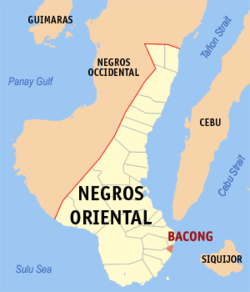Bacong, Negros Oriental
| Bacong | |
|---|---|
| Municipality | |
|
St. Augustine Church, Bacong, Negros Oriental | |
 Map of Negros Oriental with Bacong highlighted | |
.svg.png) Bacong Location within the Philippines | |
| Coordinates: 09°15′N 123°17′E / 9.250°N 123.283°ECoordinates: 09°15′N 123°17′E / 9.250°N 123.283°E | |
| Country | Philippines |
| Region | Negros Island Region (NIR/Region XVIII) |
| Province | Negros Oriental |
| Congr. district | 3rd district of Negros Oriental |
| Barangays | 22 |
| Government[1] | |
| • Mayor | Jocelyn Alviola |
| • Vice Mayor | Lenin P. Alviola |
| Area[2] | |
| • Total | 40.30 km2 (15.56 sq mi) |
| Population (2010)[3] | |
| • Total | 32,286 |
| • Density | 800/km2 (2,100/sq mi) |
| Time zone | PST (UTC+8) |
| ZIP code | 6216 |
| Dialing code | 35 |
Bacong is a fourth-class municipality in the province of Negros Oriental, Philippines. According to the 2015 census, it has a population of 36,527 people.[4] Bacong was the hometown of the Visayan hero of the Philippine Revolution, Pantaleon Villegas, better known as León Kilat.
Barangays
Bacong is politically subdivided into 22 barangays.
- Balayagmanok
- Banilad
- Buntis
- Buntod
- Calangag
- Combado
- Doldol
- Isugan
- Liptong
- Lutao
- Magsuhot
- Malabago
- Mampas
- North Poblacion
- Sacsac
- San Miguel
- South Poblacion
- Sulodpan
- Timbanga
- Timbao
- Tubod
- West Poblacion
History
The Province’s first town to the south of the capital may be its smallest, but it has some big things going for it. Its church of San Agustin, for one, has Oriental Negros’ tallest belfry, oldest main altar with gold-leafing and painted friezes, and a pipe organ from Zaragoza, Spain, installed in 1898 shortly before the revolution against Spain broke out in Oriental Negros. The only other pipe organ of similar provenance is found in Bohol. With its reasonably well-preserved complex including churchyard and convent (ca 1850), San Agustin of Bacong is one of the 26 colonial churches all over the country selected for restoration by the National Commission for Culture and the Arts.
Bacong’s historical importance is well-monumented: it is the birthplace of Oriental Negros’ hero and only Katipunero – General Pantaleon Villegas, aka Leon Kilat, whose birthday is celebrated every July 27. Barrio Isugan was site of a battle between Filipino and American soldiers.
Points of touristic interest are a string of beaches the length of the Bacong shoreline, sinamay handlooms, and the Negros Oriental Arts and Heritage (NOAH) which produces export quality stonecraft furniture, jewel boxes and fashion accessories.
One of the town’s bigger barangays, San Miguel, marks its local fiesta with a unique Sinulog de San Miguel, where the archangel and his heavenly army are depicted battling the forces of evil.[5]
Demographics
| Population census of Bacong | ||
|---|---|---|
| Year | Pop. | ±% p.a. |
| 1990 | 16,384 | — |
| 1995 | 19,177 | +2.99% |
| 2000 | 23,219 | +4.19% |
| 2007 | 28,310 | +2.77% |
| 2010 | 32,286 | +4.90% |
| 2015 | 36,527 | +2.38% |
| Source: National Statistics Office[3] | ||
Education
Public High Schools[6]
| School Name | Location |
|---|---|
| Buntod National High School | Buntod |
| Ong Che Tee - Bacong National High School | Sacsac |
| San Miguel National High School | San Miguel |
| Isugan National High School | Isugan (Planned) |
Private Schools
| School Name | Location |
|---|---|
| Bacong Holy Family High School | West Poblacion |
| Divine Grace International School | Buntis |
| DLHOH Institute Learning Center | North Poblacion |
Elementary Schools[6]
| School Name | Location |
|---|---|
| Bacong Central School | West Poblacion (Town Proper) |
| Buntod Elementary School | Buntod |
| Calangag Elementary School | Calangag |
| Fausto M. Sarono - Tubod Elementary School | Tubod |
| Isugan Elementary School | Isugan |
| Nazario Tale Memorial Elementary School | Banilad |
| Sacsac Elementary School | Sacsac |
| San Miguel Elementary School | San Miguel |
| Timbanga Elementary School | Timbanga |
| Timbao Elementary School | Timbao |
References
- ↑ "Elected Mayors – Vice-Mayors and Councilors in Negros Oriental". Dumaguete.com. Retrieved 2016-05-15.
- ↑ "Province: Negros Oriental". PSGC Interactive. Makati City, Philippines: National Statistical Coordination Board. Retrieved 13 March 2013.
- 1 2 "Total Population by Province, City, Municipality and Barangay: as of May 1, 2010" (PDF). 2010 Census of Population and Housing. National Statistics Office. Retrieved 13 March 2013.
- ↑ "NEGROS ISLAND REGION (NIR)". Census of Population (2015): Total Population by Province, City, Municipality and Barangay (Report). PSA. Retrieved 20 June 2016.
- ↑ "Negros Oriental Tourism", About | Cities & Towns. Retrieved 2013-05-28.
- 1 2 "dumaguete.com".
External links
- Philippine Standard Geographic Code
- Philippine Census Information
- Local Governance Performance Management System
 |
Dumaguete |  | ||
| Valencia | |
Bohol Sea | ||
| ||||
| | ||||
| Dauin |
